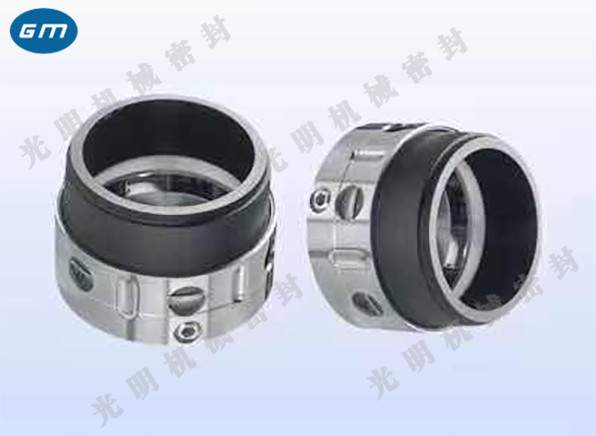General knowledge of mechanical seal Working principle of mechanical seal
Mechanical seal is a shaft seal device that can prevent leakage by a pair or several pairs of end faces that slide relative to the shaft under the action of fluid pressure and the elastic force (or magnetic force) of the compensation mechanism and are matched with auxiliary seals.
2. Selection of common materials for mechanical seal: purified water; normal atmospheric temperature; (Dynamic) 9CR18, 1CR13 surfacing cobalt chromium tungsten, cast iron; (Static) resin impregnated graphite, bronze, phenolic plastic. River water (including sediment); normal atmospheric temperature; (dynamic) tungsten carbide, (static) tungsten carbide seawater; normal atmospheric temperature; (Dynamic) tungsten carbide, 1CR13 surfacing cobalt chromium tungsten, cast iron; (Static) resin impregnated graphite, tungsten carbide, cermet; Superheated water 100 ℃; (Dynamic) tungsten carbide, 1CR13 surfacing cobalt chromium tungsten, cast iron; (Static) resin impregnated graphite, tungsten carbide, cermet; Gasoline, lubricating oil, liquid hydrocarbon; normal atmospheric temperature; (Dynamic) tungsten carbide, 1CR13 surfacing cobalt chromium tungsten, cast iron; (Static) impregnated resin or tin antimony alloy graphite, phenolic plastic. Gasoline, lubricating oil, liquid hydrocarbon; 100 degrees; (Dynamic) tungsten carbide, 1CR13 surfacing cobalt chromium tungsten; (Static) impregnated with bronze or resin graphite. Gasoline, lubricating oil, liquid fuel; Containing particles; Tungsten carbide; Tungsten carbide (static).
3. The type and use of sealing materials The sealing materials shall meet the requirements of sealing functions. Because the sealed medium is different and the working premise of the equipment is different, the sealing materials are required to have different adaptability. The requirements for sealing materials are generally: 1) the material has good compactness and is not easy to leak media; 2) Have appropriate mechanical strength and hardness; 3) Good compressibility and resilience, small permanent deformation; 4) No softening and decomposition under high temperature, no hardening and no embrittlement under low temperature; 5) It has good corrosion resistance, and can work in acid, alkali, oil and other media for a long time. Its volume and hardness change little, and it does not adhere to the metal surface; 6) Small friction coefficient, good wear resistance; 7) It has the flexibility of combining with the sealing surface; 8) Good aging resistance and durability; 9) It is convenient to process and cheap, and rubber is commonly used as a sealing material. In addition to rubber, graphite, polytetrafluoroethylene and various sealants are also suitable for sealing materials.
4. Technical essentials for installation and use of mechanical seal 1) The radial runout of equipment shaft shall be ≤ 0.04mm, and the axial runout shall not be greater than 0.1mm; 2) The sealing parts of the equipment shall be kept clean during installation, the sealing parts shall be cleaned, and the sealing face shall be intact to prevent impurities and dust from entering the sealing parts; 3) During installation, it is strictly prohibited to bump or knock, so as not to damage the friction pair of mechanical seal and cause seal failure; 4) During installation, a layer of clean mechanical oil shall be coated on the surface in contact with the seal to facilitate smooth installation; 5) When installing the stationary ring gland, tighten the screws evenly to ensure the perpendicularity between the end face of the stationary ring and the axis line; 6) . After installation, the moving ring can be moved flexibly on the shaft with a certain elasticity by pushing it manually; 7) After installation, rotate the shaft by hand, and the shaft should have no sense of weight; 8) The equipment shall be filled with medium before operation to prevent the seal from failure due to dry friction; 9) For crystallizable and granular media, corresponding flushing, filtering and cooling measures shall be taken when the medium temperature is 80 ℃. For various auxiliary devices, please refer to the relevant dimensions of mechanical seal.
10) During installation, a layer of clean mechanical oil shall be coated on the surface in contact with the seal. Special attention shall be paid to the selection of mechanical oil for different auxiliary seal materials to avoid oil invasion, expansion or accelerated aging of O-ring, which may lead to premature failure of the seal.
5. What are the three sealing points of the mechanical shaft seal, and the sealing principle of these three sealing points: the sealing between the moving ring and the stationary ring: the elastic element (spring, bellows, etc.) and the sealing liquid pressure generate an appropriate compression force (specific pressure) on the contact surface (end face) of the moving moving ring and the stationary ring to make the two smooth and straight end faces closely fit; A thin liquid film is maintained between the end faces for sealing. This film has only 1AJr static pressure, and it plays a role in balancing pressure and lubricating the end face. The reason why the inner surface needs to be highly smooth and straight is to provide a prerequisite for the seamless fitting of the end, the wound and the path and the average specific pressure, which is a relative rotary seal.???

6. General knowledge of mechanical seal Types of mechanical seal technology At present, new technologies of various mechanical seals using new materials and processes have made rapid progress, including the following new mechanical seal technologies. Rapid progress has been made with the following new mechanical seal technologies. In recent years, three kinds of grooves have been made on the sealing face of mechanical seals to produce hydrostatic and dynamic pressure effects. Zero leakage sealing technology used to think that contact and non-contact mechanical seals could not achieve zero leakage (or no leakage). Israel put forward a new concept of zero leakage non-contact mechanical end face seal by using slotted seal technology, which has been used in lubricating oil pumps of nuclear power plants. Dry running gas seal technology This type of seal uses slotted seal technology for gas seal. Upstream pumping sealing technology is to pump a small amount of downstream leakage fluid back to the upstream by using a flow groove on the sealing surface. The structural characteristics of the above types of seals are as follows: shallow grooves are used, and the film thickness and the depth of the launder belong to the micron level, and lubrication grooves, radial sealing dams and circumferential sealing weirs are used to form the sealing and bearing departments. It can also be said that the grooved seal is the combination of plane seal and grooved bearing. Its advantages are small leakage (even no leakage), large film thickness, and low contact friction, power consumption and fever. Thermohydrodynamic seal technology uses various deep sealing surface grooves to cause local thermal deformation to produce hydrodynamic wedge effect. This kind of seal with hydrodynamic bearing capacity is called thermohydrodynamic wedge seal.
Bellows sealing technology can be divided into formed metal bellows and welded metal bellows mechanical sealing technology.
Multi face seal technology includes double seal, intermediate ring seal and multi seal technology. In addition, there are parallel face sealing technology, monitoring sealing technology, combined sealing technology, etc.
7. General knowledge of mechanical seal Scouring scheme and characteristics Scouring aims to prevent the accumulation of impurities, prevent the formation of air bags, maintain and improve lubrication, etc. When the brush fluid temperature is low, it also has a cooling effect. The main flushing methods are as follows: I. Internal flushing 1. Positive flushing (1) Features: the sealed medium of the working host is introduced into the sealing chamber from the outlet end of the pump through the pipeline.
(2) Application: It is used to clean the fluid. P1 is slightly larger than P inlet. When the temperature is high or there are impurities, coolers, filters, etc. can be set on the pipeline. 2. Backwash brush (1) Features: use the sealed medium of the working host, introduce it into the seal chamber from the pump outlet, and flow back to the pump inlet through the pipeline after flushing.
(2) Application: It is used to clean the fluid, and P enters 3. Full flushing (1 feature: the sealed medium of the working host is introduced into the sealing chamber through the pipeline from the outlet end of the pump, and then flows back to the pump inlet through the pipeline after flushing.
(2) Application: The cooling effect is better than the first two. It is used to clean the fluid, and P1 is close to P inlet and P outlet.
2、 External flushing characteristics: clean fluid compatible with the sealed medium in the external system is introduced to the seal chamber for flushing.
Application: The pressure of the external flushing fluid should be 0.05-0.1MPA higher than that of the sealed medium, which is applicable to the occasions where the medium is high temperature or solid particles. The flow of flushing fluid shall ensure that it can take away heat, and meet the need of flushing, so as not to produce erosion on seals. Therefore, it is necessary to control the pressure of the seal chamber and the flow rate of the flushing fluid. Generally, the flow rate of the cleaning flushing fluid should be less than 5M/S; Slurry liquid containing particles must be less than 3M/S. In order to reach the above flow rate, The difference between flushing fluid and seal chamber pressure shall Generally, 0.05-0.1MPA is taken for O.5MPA, and 0.1-0.2MPA is taken for double end mechanical seals. The orifice where the flushing fluid enters and exits the seal chamber should be set around the seal end face and close to the moving ring side. In order to prevent the graphite ring from being eroded or deformed due to temperature difference due to uneven cooling, as well as the accumulation and coking of impurities, tangential introduction or multi-point flushing can be used. If necessary, flushing Liquid can be hot water or steam.






